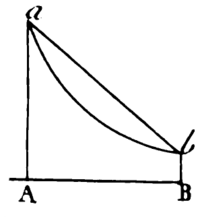with a continued motion perpendicularly into the ſame length, will deſcribe the area of an hyperbola, which ſubducted from the area SL x AB will leave ANB the area ſought. Whence ariſes this
conſtruction of the problem. At the points L, A, B

(Fig. 2.) erect the perpendiculars Ll, Aa, Bb;
making Aa equal to Ll, and Bb equal to LA. Making Ll, and LB aſymptotes, deſcribe through the points LA, the hyperbolic curve ab. And the chord ba being drawn will incloſe the area aba equal to the area ſought ANB.
Example 2. If the centripetal force tending to the ſeveral particles of the ſphere be reciprocally as the cube of the diſtance, or (which is the ſame thing) as that cube applied to any given plane; write for V, and 2PS x LD for ; and DN will become as that is (becauſe PS, AS, SI are continually proportional) as . If we draw then theſe three parts into the length AB, the firſt will generate the area of an hyperbole; the ſecond , the area ; the third , the area that is . Form the firſt ſubduct the ſum of the ſecond and third, and there will remain ANB the area ſought. Whence ariſfes this conſtruction of the problem. At the points









